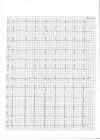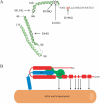Identification of rare variants in TNNI3 with atrial fibrillation in a Chinese GeneID population
- PMID: 26169204
- PMCID: PMC4713376
- DOI: 10.1007/s00438-015-1090-y
Identification of rare variants in TNNI3 with atrial fibrillation in a Chinese GeneID population
Abstract
Despite advances by genome-wide association studies (GWAS), much of heritability of common human diseases remains missing, a phenomenon referred to as 'missing heritability'. One potential cause for 'missing heritability' is the rare susceptibility variants overlooked by GWAS. Atrial fibrillation (AF) is the most common arrhythmia seen at hospitals and increases risk of stroke by fivefold and doubles risk of heart failure and sudden death. Here, we studied one large Chinese family with AF and hypertrophic cardiomyopathy (HCM). Whole-exome sequencing analysis identified a mutation in TNNI3, R186Q, that co-segregated with the disease in the family, but did not exist in >1583 controls, suggesting that R186Q causes AF and HCM. High-resolution melting curve analysis and direct DNA sequence analysis were then used to screen mutations in all exons and exon-intron boundaries of TNNI3 in a panel of 1127 unrelated AF patients and 1583 non-AF subjects. Four novel missense variants were identified in TNNI3, including E64G, M154L, E187G and D196G in four independent AF patients, but no variant was found in 1583 non-AF subjects. All variants were not found in public databases, including the ExAC Browser database with 60,706 exomes. These data suggest that rare TNNI3 variants are associated with AF (P = 0.03). TNNI3 encodes troponin I, a key regulator of the contraction-relaxation function of cardiac muscle and was not previously implicated in AF. Thus, this study may identify a new biological pathway for the pathogenesis of AF and provides evidence to support the rare variant hypothesis for missing heritability.
Keywords: Atrial fibrillation (AF); Cardiac troponin I; Hypertrophic cardiomyopathy; TNNI3 mutations; Whole exome sequencing.
Figures





Similar articles
-
Genetic Studies of Hypertrophic Cardiomyopathy in Singaporeans Identify Variants in TNNI3 and TNNT2 That Are Common in Chinese Patients.Circ Genom Precis Med. 2020 Oct;13(5):424-434. doi: 10.1161/CIRCGEN.119.002823. Epub 2020 Aug 20. Circ Genom Precis Med. 2020. PMID: 32815737 Free PMC article.
-
High prevalence of Arginine to Glutamine substitution at 98, 141 and 162 positions in Troponin I (TNNI3) associated with hypertrophic cardiomyopathy among Indians.BMC Med Genet. 2012 Aug 10;13:69. doi: 10.1186/1471-2350-13-69. BMC Med Genet. 2012. PMID: 22876777 Free PMC article.
-
Next-generation sequencing of nine atrial fibrillation candidate genes identified novel de novo mutations in patients with extreme trait of atrial fibrillation.J Med Genet. 2015 Jan;52(1):28-36. doi: 10.1136/jmedgenet-2014-102618. Epub 2014 Nov 12. J Med Genet. 2015. PMID: 25391453
-
Genetics of atrial fibrillation-an update of recent findings.Mol Biol Rep. 2022 Aug;49(8):8121-8129. doi: 10.1007/s11033-022-07420-2. Epub 2022 May 19. Mol Biol Rep. 2022. PMID: 35587846 Review.
-
Atrial fibrillation: the role of common and rare genetic variants.Eur J Hum Genet. 2014 Mar;22(3):297-306. doi: 10.1038/ejhg.2013.139. Epub 2013 Jul 10. Eur J Hum Genet. 2014. PMID: 23838598 Free PMC article. Review.
Cited by
-
Genomic Variants in NEURL, GJA1 and CUX2 Significantly Increase Genetic Susceptibility to Atrial Fibrillation.Sci Rep. 2018 Feb 19;8(1):3297. doi: 10.1038/s41598-018-21611-7. Sci Rep. 2018. PMID: 29459676 Free PMC article.
-
Troponin I - a comprehensive review of its function, structure, evolution, and role in muscle diseases.Anim Cells Syst (Seoul). 2025 Jul 28;29(1):446-468. doi: 10.1080/19768354.2025.2533821. eCollection 2025. Anim Cells Syst (Seoul). 2025. PMID: 40735528 Free PMC article. Review.
-
Identification of a mutation in CNNM4 by whole exome sequencing in an Amish family and functional link between CNNM4 and IQCB1.Mol Genet Genomics. 2018 Jun;293(3):699-710. doi: 10.1007/s00438-018-1417-6. Epub 2018 Jan 10. Mol Genet Genomics. 2018. PMID: 29322253 Free PMC article.
-
Genomic Variant in IL-37 Confers A Significant Risk of Coronary Artery Disease.Sci Rep. 2017 Feb 9;7:42175. doi: 10.1038/srep42175. Sci Rep. 2017. PMID: 28181534 Free PMC article.
-
A SHOX2 loss-of-function mutation underlying familial atrial fibrillation.Int J Med Sci. 2018 Oct 20;15(13):1564-1572. doi: 10.7150/ijms.27424. eCollection 2018. Int J Med Sci. 2018. PMID: 30443179 Free PMC article.
References
-
- Benjamin EJ, Rice KM, Arking DE, Pfeufer A, van Noord C, Smith AV, Schnabel RB, Bis JC, Boerwinkle E, Sinner MF, Dehghan A, Lubitz SA, D'Agostino RB, Sr, Lumley T, Ehret GB, Heeringa J, Aspelund T, Newton-Cheh C, Larson MG, Marciante KD, Soliman EZ, Rivadeneira F, Wang TJ, Eiriksdottir G, Levy D, Psaty BM, Li M, Chamberlain AM, Hofman A, Vasan RS, Harris TB, Rotter JI, Kao WHL, Agarwal SK, Stricker BHC, Wang K, Launer LJ, Smith NL, Chakravarti A, Uitterlinden AG, Wolf PA, Sotoodehnia N, Kottgen A, van Duijn CM, Meitinger T, Mueller M, Perz S, Steinbeck G, Wichmann HE, Lunetta KL, Heckbert SR, Gudnason V, Alonso A, Kaab S, Ellinor PT, Witteman JCM. Variants in ZFHX3 are associated with atrial fibrillation in individuals of European ancestry. Nat Genet. 2009;41:879–881. - PMC - PubMed
-
- Bhavsar PK, Brand NJ, Yacoub MH, Barton PJ. Isolation and characterization of the human cardiac troponin I gene (TNNI3). Genomics. 1996;35:11–23. - PubMed
-
- Camm AJ, Lip GYH, De Caterina R, Savelieva I, Atar D, Hohnloser SH, Hindricks G, Kirchhof P, Bax JJ, Baumgartner H, Ceconi C, Dean V, Deaton C, Fagard R, Funck-Brentano C, Hasdai D, Hoes A, Knuuti J, Kolh P, McDonagh T, Moulin C, Popescu BA, Reiner Ž , Sechtem U, Sirnes PA, Tendera M, Torbicki A, Vahanian A, Windecker S, Reviewers D, Vardas P, Al-Attar N, Alfieri O, Angelini A, Blömstrom-Lundqvist C, Colonna P, De Sutter J, Ernst S, Goette A, Gorenek B, Hatala R, Heidbüchel H, Heldal M, Kristensen SD, Le Heuzey J-Y, Mavrakis H, Mont L, Filardi PP, Ponikowski P, Prendergast B, Rutten FH, Schotten U, Van Gelder IC, Verheugt FWA. 2012 focused update of the ESC Guidelines for the management of atrial fibrillation: An update of the 2010 ESC Guidelines for the management of atrial fibrillation Developed with the special contribution of the European Heart Rhythm Association. European Heart Journal. 2012;33:2719–2747. - PubMed
Publication types
MeSH terms
Substances
Grants and funding
LinkOut - more resources
Full Text Sources
Other Literature Sources
Medical
Research Materials

